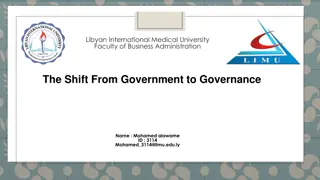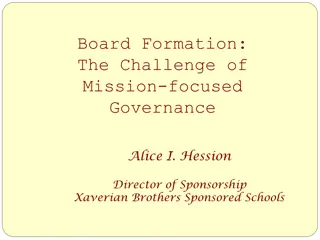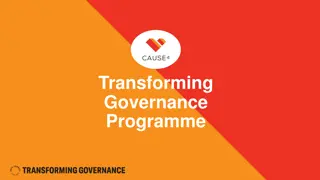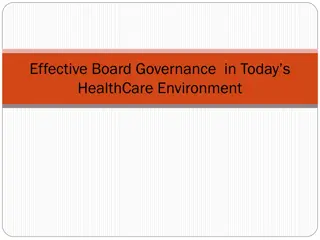Chamberlanders Governance Survival Guide: Empowering Effective Chamber Leadership
A comprehensive guide for Chamberlanders focusing on governance essentials, including roles, financial responsibilities, committees, and legal duties. Learn about the ACC's mission, advocacy efforts, connecting chambers at different levels, and the importance of mission and vision statements.
Download Presentation

Please find below an Image/Link to download the presentation.
The content on the website is provided AS IS for your information and personal use only. It may not be sold, licensed, or shared on other websites without obtaining consent from the author.If you encounter any issues during the download, it is possible that the publisher has removed the file from their server.
You are allowed to download the files provided on this website for personal or commercial use, subject to the condition that they are used lawfully. All files are the property of their respective owners.
The content on the website is provided AS IS for your information and personal use only. It may not be sold, licensed, or shared on other websites without obtaining consent from the author.
E N D
Presentation Transcript
A survival Guide for Chamberlanders - Governance 101 Tracy Acorn, Manager Chamber Services May 2019 1
Topics Role/ Purpose of the ACC Practical Board Tips Financial Responsibilities Committees Meetings Recruiting Leaders Missions/Vision Legal Duties Board Responsibilities 2
Ground Rules Informal session- ask questions as they arise Put your Chamber hat on & think in terms of your role as a director and the future wellbeing of YOUR Chamber Alberta Chambers , Geared for Success 3
Thanks! 4
Why are we here? Because you Rock! 5
Role of the ACC We are a federation of 122 provincial Chambers Represent the business interests of over 25,5000 members in 28 federal and 87 provincial electoral districts We are The Advocate for Alberta Business One influential and respected voice in matters of provincial and federal concern We provide leadership giving business a strong and collective voice 6
Your Chamber How do you connect to the ACC and the CCC? Municipal advocacy 124 chambers Provincial advocacy 124 chambers Federal advocacy 124 chambers (and proxy vote) September 2018 7
ACC Committees Policy & Advocacy Audit Nominating Executive The ACC is always looking for business minded individuals. I invite you to look into how you may serve at the Alberta Chamber level. 8
How is your Chamber Incorporated? Why does this matter? What do you need to know? BOTA and Societies Act 10
Mission and Vision Statements and Why do they matter? Mission statements focus on today and what your chamber does to achieve it. Answers the What, Who and How? Visions statements focus on tomorrow and what your chamber wants to become. Speaks to aspirations, who and what are we aspiring to change and what problem are we solving? Values statements define the ethics of your chamber. 11
Membership Approves Bylaws Elects Appoints Committees & Task Forces Policy/Goals Investigate &recommend action Board Executive Director & Suport Staff Your Staff carry out initiatives, investigate and recommend actions to be decided on by the board. 12
Board of Trade or Societies Act No item on a lower step can contradict anything above Bylaws Policies Procedures 13
Board of Directors Working vs. Governance is there really one kind of board? No, not completely - all boards Work on some level, but Governance is a MUST. 15
Whats the difference, you Ask? Activity What distinguishes a working board's involvement in a chambers operations or capitol needs, from what a board focused solely on the governing function does is simply the kind of activity undertaken by each. Successful Boards do BOTH Governance is a must, it s not an either or proposition % 0f time staff, (when lucky enough to he them) to help shape the dynamic. A working board should set their agendas putting the governance segment first. If the staff levels or In the Weeds operations, come first it can be quite challenging to shift to the more strategic view that s necessary to make good governing decisions. It's generally easier to shift "down" than "up ! A good board understands that the Work has to happen while they strategically move towards a more governance focus. 16
Your Chamber is a business so what's your plan? NFP refers only to your Chambers tax status and NOT your business plan Everything you do should , Make you MONEY Make you FRIENDS Make you FAMOUS Goal 15-20% revenue on events and educational sessions 17
The Boards JOB (Yes you have one) 1. To DIRECT 2. To PROTECT The Two dimensions of an effective board SMART HEALTHY Governance- the board exercises it s authority and direction over the Chamber on behalf of it s members 18
You are the Ambassadors for your Chamber Always have 2-3 questions or topics your board can discuss when opportunities arise. This keeps you cohesive and relevant. Questions need to be specific and not allow for yes or no answers. 19
The Secret Formula for organizational success Board Power-Jim Brown The Secret Formula for organizational success Membership Board ED or CEO Staff and volunteers Operations for Membership 20
Theres business to be done, but lets REMEMBER TO HAVE SOME FUN! 21
Board Legal Considerations Duty of care Good business judgment at all times, Due diligence in decision making Duty of loyalty Avoid Conflicts of interest Duty of Obedience Faithful to the Chambers Mission & Goals, Follow your governing documents 22
Board Legal Considerations Courts have given common terms to: Honesty; Directors must tell not only the truth but also the whole truth Duty of Care; Requires caution and conscientiousness Duty of Diligence; Make those inquiries, which a person of ordinary care in their position or in managing their affairs would make. Directors rely on Officers and outside experts at their own risk 23
Board Legal Considerations Duty of Prudence; requires Directors to use common sense. Acting prudently is acting carefully, deliberately and cautiously trying to foresee the probable consequences of the act. Duty of Skill; In Common law, a Director is not required to exercise a greater degree of skill than can be reasonably expected from a person of their knowledge and experience . Directors are not liable for mere errors in judgment. There is absolutely nothing that can be contained in a contract or in the constitution or bylaws that relieves a Director of these duties. 24
What YOU CANNOT do to Minimize risk 1)Do nothing- Taking no action is no excuse even if you did not directly participate 2) See no evil- You must do whatever necessary to correct a wrong 3) Resign- resigning after you see an issue that is not corrected does not remove liability 25
What YOU CAN do to Minimize Risk 1) Know the people involved 2) Know your bylaws 3) Have a working knowledge of what s going on 4) Monitor the finances 5) Use common sense and intuition 6) Liability Insurance for Directors is a MUST 26
Code of Conduct 1) Direct the activities AS A WHOLE 2) Maintain confidentiality of the details & dynamics 3) Contributions are positive, constructive and ALL interactions are courteous and respectful 4) All issues of importance are ratified by the Board 5) Always adhere to your Mission and Bylaws 27
YOU CANT BE ALL THINGS TO ALL PEOPLE, so take care of your fans! Decide what makes your Chamber Money, friends and famous. The best thing about chambers is that we dip our toes into so many pools, and the worst things about chambers is that we dip our toes into so many pools 29
Projects and Events When planning any project or event ask the following; Is it a Mission fit? 1) Will it build strength for the business community? 2) Will it strengthen communications and relationships? 3) Will it strengthen the advocacy process (governmental affairs)? 4) Is it value added for our membership? 5) Are we making Money, friends and our Chamber famous? 30
Cautionary Notes Your Membership is the first and last authority - A Director has no authority to commit the Chamber to any action, project of financial obligation - No Director may speak for the Chamber except on matters where the Chamber has a clearly defined policy - Avoid conflicts of interest 33
Conflict of Interest A conflict of interest occurs when an individual or organization is involved in multiple interests, one of which could possibly corrupt their motivation. A conflict of interest exists if the decision COULD be influenced it is not necessary that the influence actually takes place.(Excerpt from a policy template developed by the BC Law Reform Commission) 34
The Board Staff Relationship The Board and Staff MUST be partners, collaborating and aligned for the good of the Chamber Tips: Avoid micromanagement Be clear with your expectations Respect time Understand all that happens in the day to day when adding more tasks or events The Board is responsible for creating the future, not minding the shop John Carver 35
Reality Check Your ED s are supposed to grow the business and help to transform your community! Chamber Managers have an average tenure of 1.5 years New Boss every year, New Directors every year New Challenges every day on top of day to day administration, Events and often limited pay rates, limited budgets. Please consider as a Board how you can show the paid positions in your Chamber appreciation. 36
Budget & Finances Your budget is your future. Your Chamber s program should be based on; Clear cut objectives Realistic goals Ample finances to achieve the goal If the goal is good for the chamber and achievable go for it Operating reserve (6-12 months) & Capital budget a) b) c) d) e) Non Profit is your tax status-not your business plan 37
Practical Steps for Board Service To make the most out of your Service for both you and the Chamber consider; Attend all Board and general meetings Start and end meetings on time (Chair) Review agenda and supporting documents prior Be prepared if you are to present or speak on an issue Treat all discussions and information as confidential when applicable Chair at least one committee Go through the President for any requests of staff 1) 2) 3) 4) 5) 6) 7) 38
Role of the President The President provides leadership to the Board of Directors ensuring policy and procedure is followed Chair and implement the planned agenda for all meetings 1) Act as a guide not as a boss 2) Ensure ALL board members have an opportunity to speak and share their opinions, and knowledge in a respectful environment 3) Respect start and end times for all meetings 4) Represent your Boards decisions at community meetings and events 5) Be the liaison between the wishes of the Board and your Staff 6) Meet regularly with your Executive Director (ED) or Manager 7) In consultation with your Board and Executive committee annually review performance of ED. Provide constructive feedback to improve performance when needed. 8) Act as a signing officer for the Chamber 9) 40
Role of the Vice President or Chair The Vice or Incoming President provides leadership to the Board in the absence of the President 1) Chair meetings when President is absent 2) Serve as an Officer and signing authority for the Chamber 3) Learn the role of the President and develop relationships with Staff. 41
Role of the Treasurer The Treasurer ensures proper financial records are maintained and assist in preparation of the annual budget 1) Ensures that all expenditures of the Chamber are accurately recorded 2) Be a signing Officer and ensure banking is done regularly via staff 3) Present financials at Board and general meetings as required 4) Assist in preparation and monitoring of events and annual budgets 5) Work with the staff who perform accounting functions 42
Role of the Past President The Past President provides continuity to the Board, especially during transition 1) Assist the Newly elected President as needed 2) Often Chairs the Nominating Committee 3) Provides historical knowledge 43
Role of the Executive Director The ED ensures adequate records are maintained & assists in conducting the business affairs in accordance with directives and policies Manage the day to day affairs Hire and discharge any additional staff Prepare for, record and circulate minutes of meetings Ensure files for financials, minutes, correspondence and other relative information is maintained Act as a signing authority for the Chamber 44
Executive Committee The goal for an Executive Committee is to conduct business between Board meetings with recommendations to be ratified by Board - Authorized by the bylaws and restricted by established polices and precedents - Allows important business to be conducted as emerging issues arise 45
Financial Responsibilities The Board is responsible to Review all financial reports 1) Prepare and Approve Annual Budget (Treasurer and ED) 2) Present financial reports (monthly, event and project based) 3) Ensure year end procedures are completed as per bylaws 4) 46
Financial Responsibilities Tenders and Quotes Operational Policy for ED/ staff HR committee Year End Procedures 47
Committees Committees Make your Board Successful After your AGM set up Chairs for annual committees from your board of Directors. Ask your members to sit on committees. This helps the staff and board get work done Allow for functional, productive Board meetings not clogged up with general decisions 49























